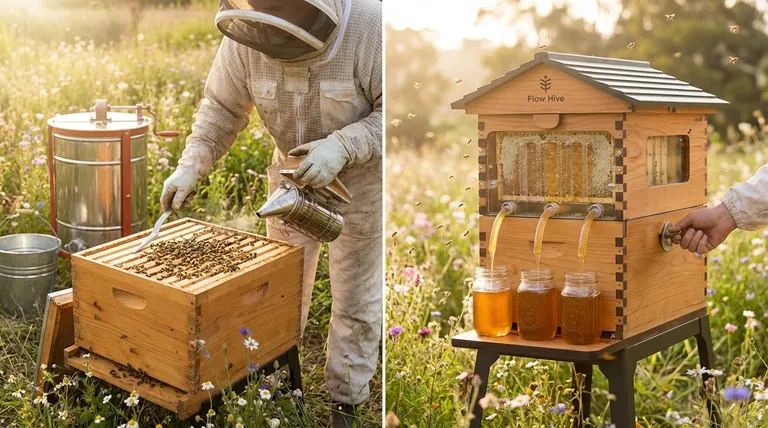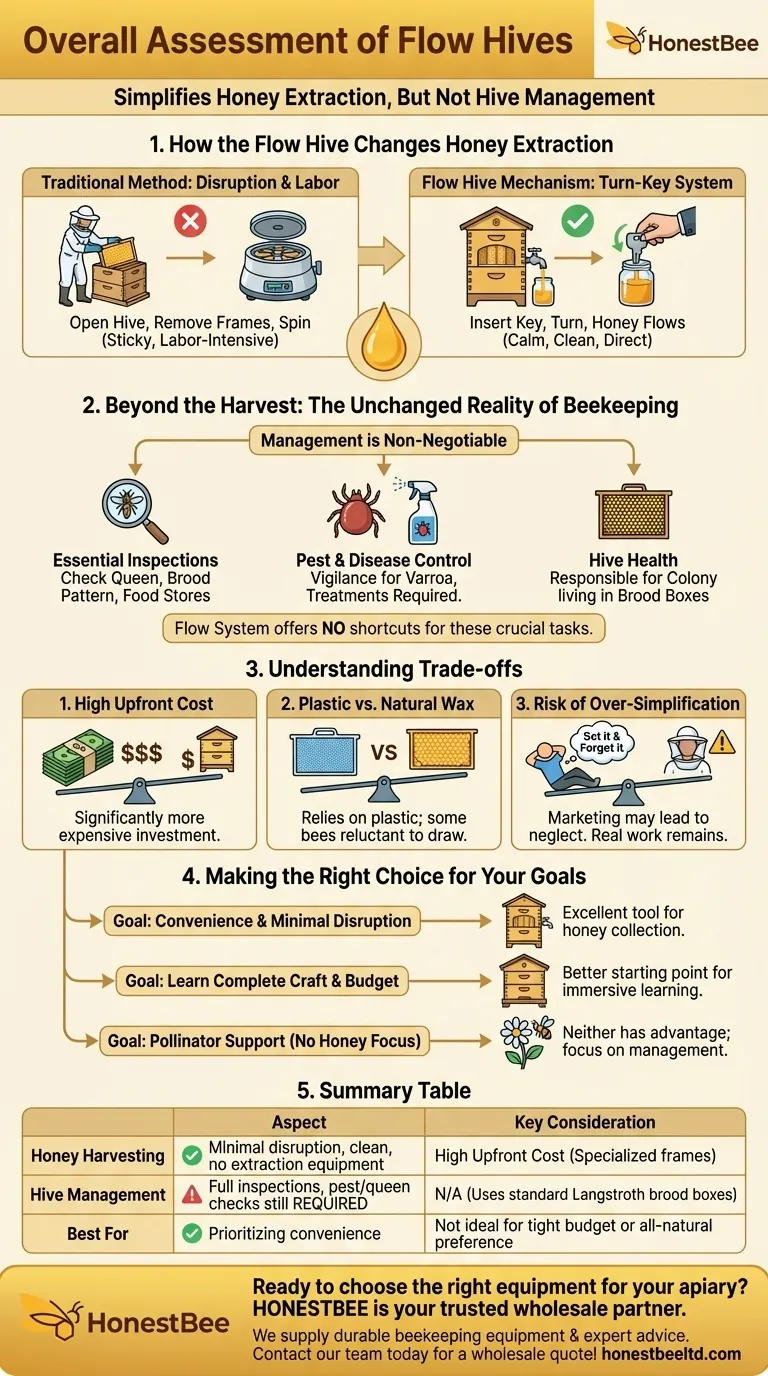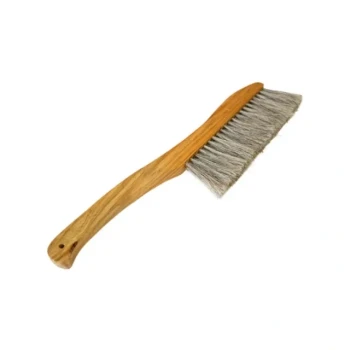In the world of beekeeping, the Flow Hive represents an innovative system designed to drastically simplify honey harvesting, making the process less stressful for bees and less labor-intensive for the beekeeper. It accomplishes this using specialized plastic frames that allow honey to be drained directly from the hive via a tap, eliminating the need to open the hive, remove frames, or use extraction equipment. While its convenience is a major draw, it does not remove the core responsibilities of hive management.
The Flow Hive excels at making honey extraction remarkably simple and non-invasive. However, its greatest strength can also be a pitfall, as its "easy honey" marketing may cause new beekeepers to underestimate the critical, year-round work of hive health management essential for any colony's survival.

How the Flow Hive Changes Honey Extraction
The core innovation of the Flow Hive is not in how bees are kept, but in how their honey is harvested. Understanding this distinction is key to a fair assessment.
The Traditional Method: Disruption and Labor
Traditionally, harvesting honey involves opening the hive, removing frames, and transporting them to a separate location. The beekeeper must then cut the wax cappings off the honeycomb and use a centrifuge to spin the honey out of the frames, which is a sticky and labor-intensive process.
The Flow Hive Mechanism: A Turn-Key System
The Flow Hive replaces standard honey frames with pre-formed, plastic split-cell frames. When it's time to harvest, the beekeeper inserts a special key and turns it. This action splits the cells vertically, creating channels that allow the honey to flow down and out of a spout, directly into a jar.
The Result: Calm Bees and Clean Honey
This method significantly reduces stress on the colony, as the hive is not opened and the bees are not disturbed during the harvest. The honey is also exceptionally clean, as it flows directly from the comb without exposure to air or processing.
Beyond the Harvest: The Unchanged Reality of Beekeeping
The convenience of the Flow Hive is limited to honey extraction. The rest of the beekeeping calendar, which constitutes the vast majority of the work, remains unchanged.
Management is Non-Negotiable
A Flow Hive is essentially a standard beehive box (a Langstroth hive) fitted with specialized honey frames. The beekeeper is still fully responsible for managing the health and productivity of the colony living in the brood boxes below.
Essential Hive Inspections
Regular inspections are critical. This means opening the hive to check on the queen's health, look for a healthy brood pattern, and ensure the colony has adequate food stores. The Flow system does not provide a window into these essential metrics.
Pest and Disease Control
Threats like the Varroa mite can devastate a colony. A beekeeper using a Flow Hive must be just as vigilant about inspecting for and treating pests and diseases as any traditional beekeeper. The equipment offers no shortcuts for this crucial task.
Understanding the Trade-offs
No system is perfect, and the Flow Hive's unique design comes with specific considerations. An objective assessment requires acknowledging these trade-offs.
High Upfront Cost
Flow Hives and their specialized frames are significantly more expensive than standard Langstroth equipment. This initial investment can be a major barrier for new beekeepers.
Plastic vs. Natural Wax
The system relies entirely on injection-molded plastic frames. Some beekeepers have a philosophical preference for natural materials like wood and wax. Furthermore, some colonies can be reluctant or slow to draw out and fill plastic foundation compared to natural beeswax.
The Risk of Over-Simplification
The primary criticism from experienced beekeepers is that the Flow Hive's marketing can create a "set it and forget it" mentality. This may attract beginners who are unprepared for the real work of beekeeping, potentially leading to hive neglect and failure.
Making the Right Choice for Your Goals
Your decision to use a Flow Hive should be based on a clear understanding of your personal goals, budget, and commitment to the craft.
- If your primary focus is convenience and minimizing harvest-day disruption: The Flow Hive is an excellent tool that delivers exactly what it promises for honey collection.
- If your primary focus is learning the complete craft of beekeeping on a tight budget: A traditional Langstroth hive is a better starting point, as it immerses you in every aspect of the process.
- If your primary focus is simply supporting pollinators with less interest in harvesting honey: Neither system has an advantage, as your work will be focused entirely on hive management, not honey supers.
Ultimately, a successful and healthy hive depends not on the equipment used for harvesting, but on the knowledge and diligence of the beekeeper.
Summary Table:
| Aspect | Flow Hive Advantage | Key Consideration |
|---|---|---|
| Honey Harvesting | Minimal disruption, clean honey, no extraction equipment needed. | High upfront cost for specialized frames. |
| Hive Management | N/A (Uses standard Langstroth brood boxes). | Full, regular inspections for health, pests, and queen are still required. |
| Best For | Beekeepers prioritizing harvest convenience and less bee stress. | Not ideal for those on a tight budget or preferring all-natural materials. |
Ready to choose the right equipment for your apiary?
Whether you're a commercial beekeeper evaluating the efficiency of Flow Hive components or a distributor looking for reliable, high-volume supplies, HONESTBEE is your trusted wholesale partner. We supply durable beekeeping equipment and expert advice to help you manage healthy, productive colonies.
Contact our team today to discuss your specific needs and get a wholesale quote!
Visual Guide

Related Products
- HONESTBEE Professional Long Handled Hive Tool with Precision Cutting Blade
- Professional Grade Foldable Beehive Handles
- Professional Galvanized Hive Strap with Secure Locking Buckle for Beekeeping
- HONESTBEE Professional Hive Top Bee Feeder Feeding Solution
- Wooden Bee Brush with Double-Row Horsehair Bristles
People Also Ask
- How should beekeepers handle bees when using a hive tool? Master Calm, Deliberate Techniques
- What is a hive tool and what are its uses? Master Your Hive Inspections with the Essential Beekeeper's Tool
- What is a hive tool used for in beekeeping? Your Essential Guide to Hive Management
- What is the hive tool used for? The Essential Multi-Tool for Every Beekeeper
- Why do hive tools have a hole? Unlock the Secret to Efficient Beekeeping



















